7.4 Updating the Server
After the server has been registered in the Novell Customer Center, you can apply updates via packages and patches. The default GNOME desktop indicates when there are updates available to the server. You can update the server from any of the following interfaces.
7.4.1 Updating the Server Base from SLES 10SP3 to SLES10 SP4
Prerequisites
-
Ensure you have enough disk space in /var/cache/zmd where the update process downloads all the updates to.
-
Register the SLES 10 SP 3 server in the Novell Customer Center.
-
Ensure that the server meets the upgrade requirements. See Meeting the Upgrade Requirements.
-
Install the move-to-sles10-sp4 patch on the server. This is an optional patch and will never be installed automatically.
-
If you are using rug, enter the following command at a terminal prompt:
rug in -t patch move-to-sles10-sp4 && rug ping -a
-
If you are using the GUI Software Updater, click , then select the move-to-sles10-sp4 patch, and click .
-
-
Answer all of the prompts in the affirmative until the move-to-sles10-sp4 patch is installed.
-
Verify that the SUSE-Linux-Enterprise-Server-SP4-migration, OPEN_ENTERPRISE_SERVER_SP3 and SUSE_SLES_SP3 products are installed along with their associated channels by entering the following command at a terminal prompt:
rug pd -i
-
Install the recommended patches that are in the channels using rug up -t patch -g recommended && rug ping -a
-
Repeat Step 5, answering all of the prompts in the affirmative until you are prompted to reboot server.
-
(Optional) Create an answer file. See Creating a Password Answer File.
-
Reboot the server.
-
If you did not provide a password answer file (Creating a Password Answer File), you must enter the passwords for the LDAP (eDirectory) Admin user and (if applicable) the DSfW Domain Administrator to start the configuration process.
If you provided an answer file, the service configuration process continues automatically.
IMPORTANT:If an error occurs, for example if the wrong password is entered, you can rerun the configuration phase again by either
-
Rebooting the server
or
-
Entering the following command at a terminal prompt:
sudo yast2 channel-upgrade-oes
-
-
Various messages indicate the services being configured. When the Login prompt appears, verify that the upgrade was successful. See the procedures in Verifying That the Installation Was Successful.
-
Verify that the base has changed to SLES 10 SP4 by using the SPident --vv command. Ensure that the output does not throw up any conflicts.
NOTE:If the message NOT upto date is displayed when you run the SPident (Service Pack Identification) tool, then install the latest rpms of fuse, libfuse2, and ruby using the following commands:
-
rug in fuse
-
rug in libfuse2
-
rug in ruby
-
-
Complete the server setup by following the procedures in Completing OES Installation or Upgrade Tasks.
7.4.2 Updating the Server by Using the Command Line
After you have registered the server in the Novell Customer Center, you can update the server by using commands at the command line. The following procedure specifies steps for updating the server with all available patches for SLES 10 SP4 and OES 2 SP3.
-
Log in to the server as root or su to root.
-
At the command line, enter the following commands. The screen shots show example output.
-
Refresh all services:
rug ref

-
See whether updates are available for SLES 10 SP4 and OES 2 SP3:
rug lu catolog1 catalog2
For example:
rug lu SLES10-SP4-Updates OES2-SP3-Updates
-
No updates available:

-
Updates available:
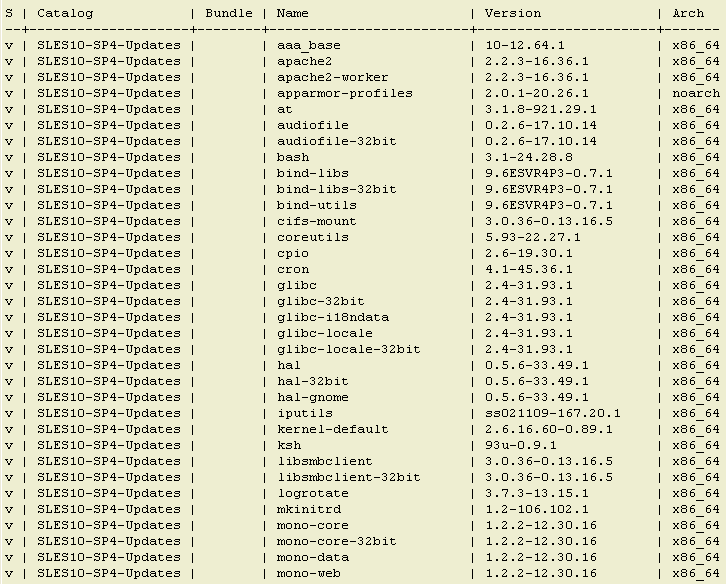
-
-
Update the server with all available SLES10 SP4 and OES 2 SP3 patches:
rug up -t patch SLES10-SP4-Updates OES2-SP3-Updates
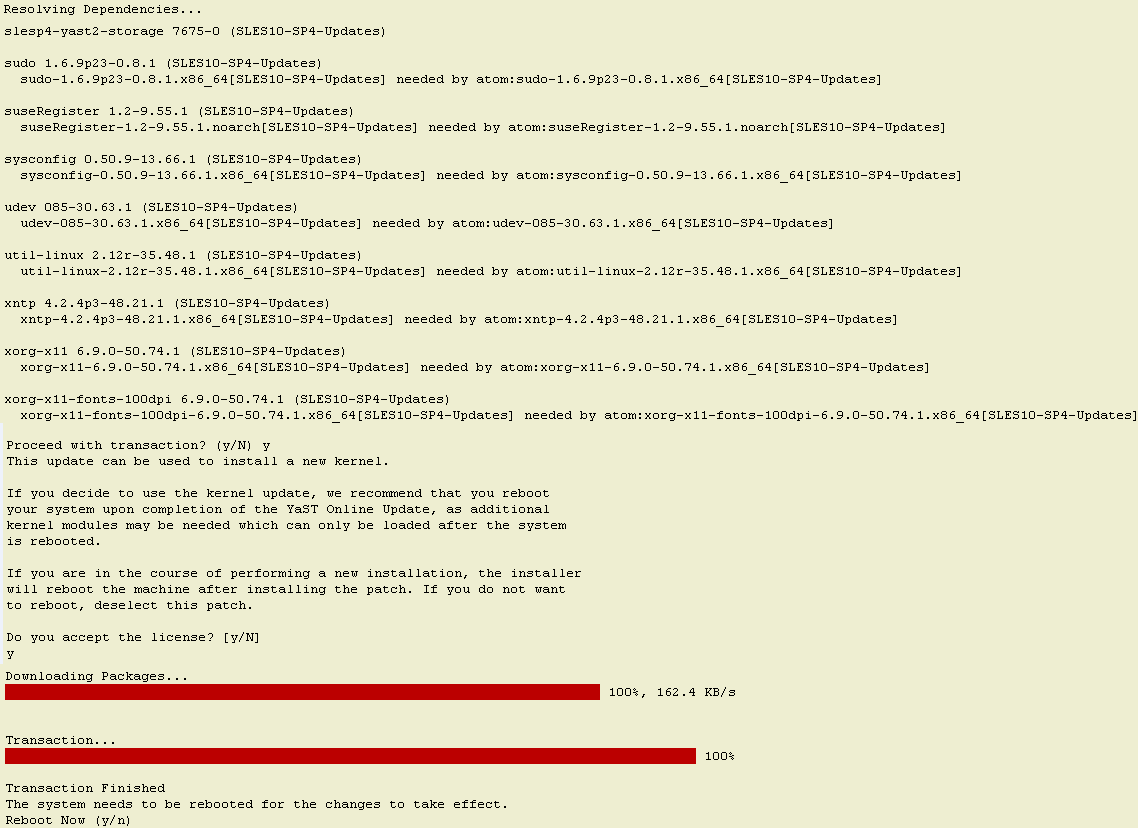
-
Repeat Step 2.b and Step 2.c until no more updates are available.
-
To finish the update, reboot the server.
Rebooting the server activates the new kernel if it has been updated and ensures that OES services that need restarting after patching are restarted.
-
You can also update your server with specific maintenance patches by using commands at the command line:
-
Log into the server as root or su to root.
In the steps that follow, screen shots show example output.
-
Refresh all services
rug ref

-
See whether updates are available, see a list of patches and their status, or see information for a specific patch:
-
See whether patches are available:
rug lu catalog1 catalog2
-
No updates available in the specified catalogs:

-
Updates available in the specified catalogs:

-
-
See a list of patches from all catalogs and their status:
rug pch
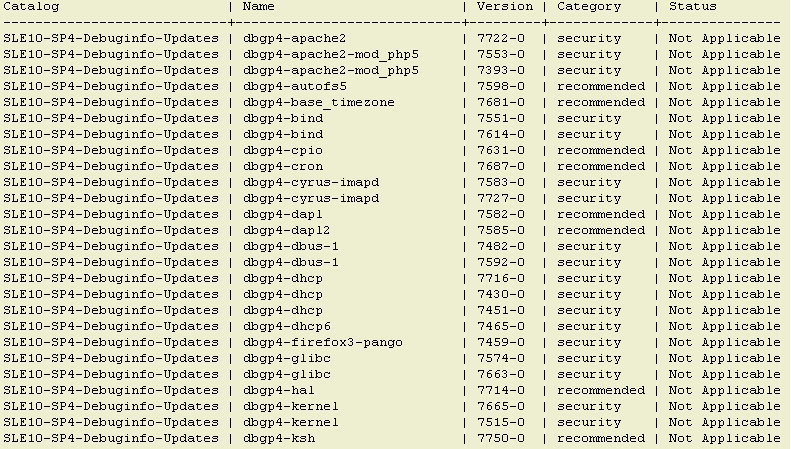
-
See a list of all installed patches:
rug pch -i
-
Before patches are installed:

-
After two patches are installed:

-
After all patches have been installed:
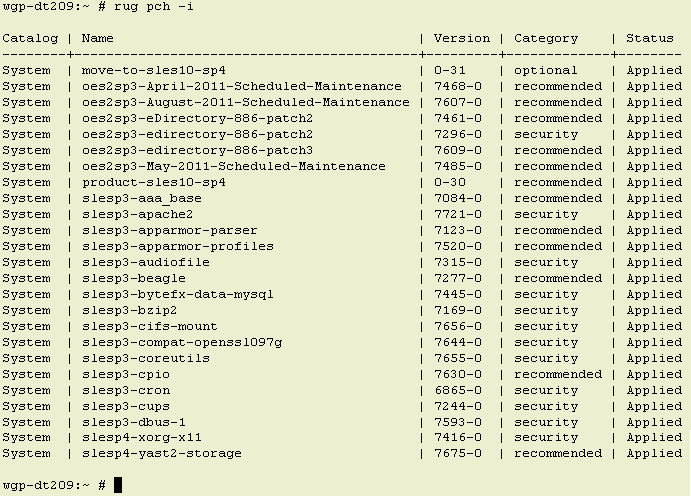
-
-
See a list of all installed patches:
rug pch -i
-
Before patches are installed:

-
After two patches are installed:

-
After all patches have been installed:

-
-
See information for a specific patch:
rug patch-info patch_name
For example:
rug patch-info oes2-oes-SPident
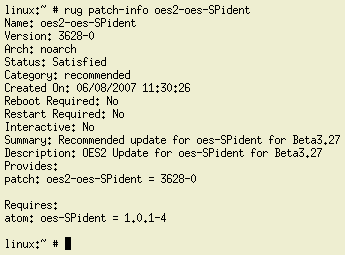
-
-
Update the server with specific patches:
-
Install all patches from the one or more catalogs of a particular category, such as:
-
security
-
recommended
-
optional
rug up -t patch catalog1 catalog2 ‑g category_name
For example:
rug up -t patch SLES10-SP4-Updates OES2-SP3-Updates ‑g security
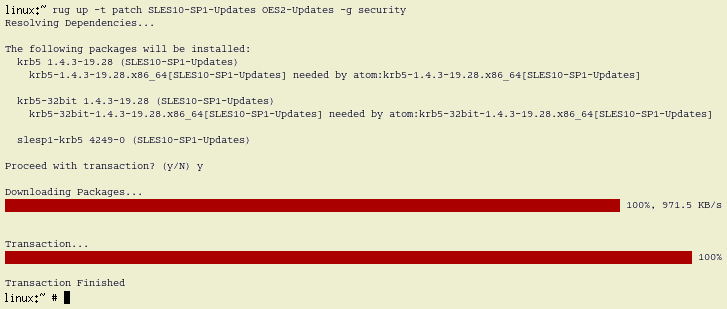
-
-
Install one version of a patch without confirmation:
rug in -t patch -y patchname-version
For example:
rug in -t patch -y oes2-CASA-3904-0
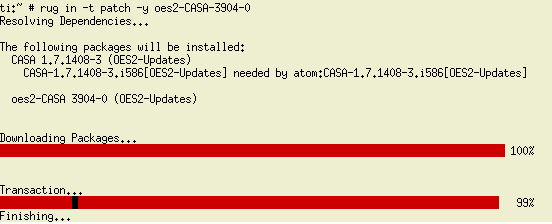
-
Install all versions of a patch with confirmation:
rug in -t patch patch_name*
For example:
rug in -t patch oes2-oes-SPident*

-
-
To finish the update, reboot the server.
Rebooting the server activates the new kernel if it has been updated and ensures that OES services that need restarting after patching are restarted.
The following table shows some additional commands you might want to use:
Table 7-1 Additional Rug Commands
|
Task |
Command |
|---|---|
|
Halts the ZLM daemon. Accepts the following option flags:
|
rug shutdown [options] |
|
Restarts the ZLM daemon. Accepts the following option flags:
|
rug restart [options] |
|
Access help for all the rug commands |
rug |
|
Access the rug man page |
man rug |
7.4.3 Updating the Server from the GNOME or KDE Desktop
-
Log into the server as root or su to root.
-
Click the icon
 , which indicates that updates are available
, which indicates that updates are available
On the GNOME Desktop, the icon is on the taskbar.
On the KDE Desktop, click > > icon

If no updates are available, the Novell Updater icon changes appearance to a globe.

-
On the Software Available for Updates page, select the updates that you want to install, then click .
Updates that have a Security or Recommended status are usually preselected.
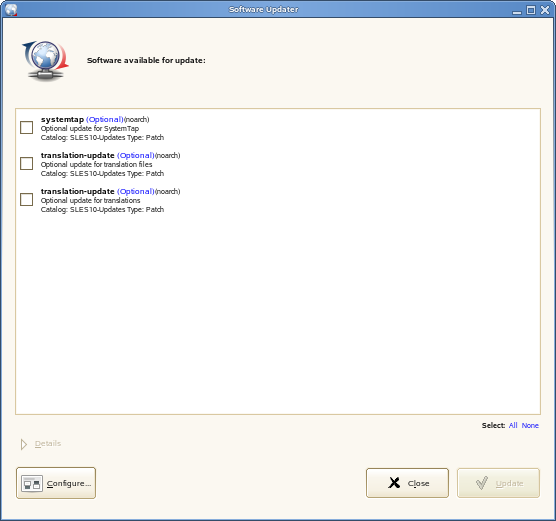
-
When the Software Updater Information status indicates that the update was successful, click .
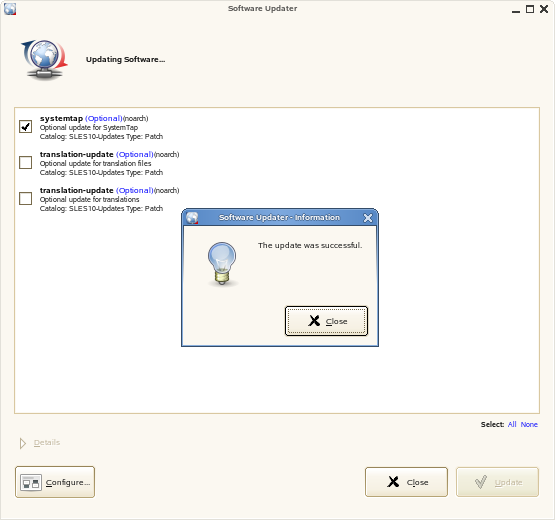
-
If necessary, rerun the updater until all the desired patches have been installed.
-
To finish the update, reboot the server.
Rebooting the server activates the new kernel if it has been updated and ensures that OES services that need restarting after patching are restarted.